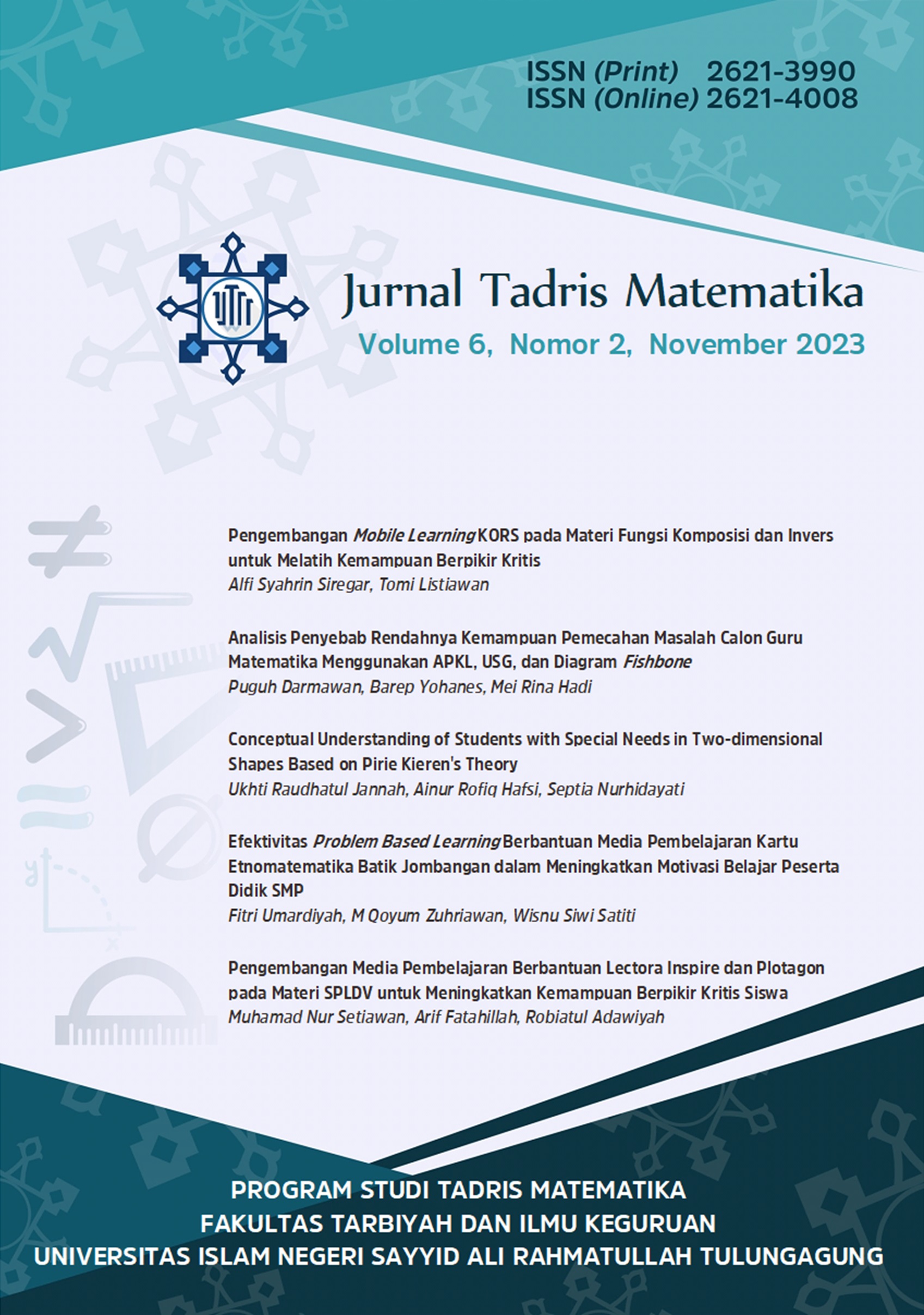Abstract
This study aims to describe the conceptual understanding of two-dimensional shapes in students with special needs based on Pirie Kieren's theory in terms of learning motivation. This research is a case study with the research subject is 1 students with special needs of class IV at SDN Pademawu Timur V The results of this study are low learning motivation with layers of understanding on the square starting from Image making then head to property noticing to ineffective folding back to image making and do ineffective folding back again to primitive knowing. In solving the square problem, the subject doubled back to ineffective image-making and primitive knowing. Meanwhile, in the rectangular problem, the subject does one folding back to image making. There are similarities in solving square and rectangular problems, for example, the subject describes the two-dimensional shape first before image making and folding back because they don't know how to calculate the area of a square and rectangle. From the similarities and differences in the thinking flow of students with special needs in squares and rectangles, educators are expected to be able to pay attention to their understanding abilities and learning motivation before carrying out learning.
References
Asih, Rohman, N., & Utami, A. D. (2020). Profil lapisan pemahaman konsep barisan dan deret berdasarkan teori Piere Kieren. Jurnal Ilmiah Pendidikan Matematika (JIPM), 2(1), 12–34. Retrieved from: https://doi.org/10.36379/jipm.v2i1.125
Djumali, S., Ali, S. T., Santoso, J., Subadi, T., Chorli, A., & and Wardhani, J. D. (2014). Landasan pendidikan. Yogyakarta: Gava Media.
Gokalp, N.D., Bulut, S. (2018). A new form of understanding maps: Multiple representations with Pirie and Kieren model of understanding. IJISME, 26(2). Retrieved form: https://openjournals.library.sydney.edu.au/index.php/CAL/article/view/12454/0
Gülkılıka, H., Uğurlub, H. H., & Yürükc, N. (2015). Examining students’ mathematical understanding of geometric transformations using the Pirie-Kieren model. Kuram ve Uygulamada Egitim Bilimleri, 15(6), 1531–1548. https://doi.org/10.12738/estp.2015.6.0056
Hadi, A. M. (2018). Analisis proses pembelajaran matematika anak berkebutuhan khusus (ABK) dalam memahami bangun datar berdasarkan teori Van Hiele di SMPLB B-D Kota Bima. Prosiding Silogisme, 18. Retrieved from: http://prosiding.unipma.ac.id/index.php/PSNPM/article/view/600
Hasanah, I. N. (2019). Profil pemahaman konsep teori Pirie dan Kieren pada penyelesaian masalah ditinjau dari pemahaman konsep geometri di SMP berbasis boarding school [PMIPA]. Tesis. Surabaya: Universitas Islam Negeri Surabaya.
Jannah, U. R., Amiruddin, M., & Nurhidayati, S. (2022). Profile of the concept understanding of two-dimensional figure based on Pirie Kieren’s theory reviewed from learning motivation in elementary school. Jurnal Pendidikan MIPA, 23(3), 1135–1148. https://doi.org/10.23960/jpmipa/v23i3.pp1135-1148
Jannah, U. R., Basri, H., Hafsi, A. R., Linarsih, Y., & Utami, M. R. (2021). Understanding concepts of multiplication number for slow learner student through meaningful learning at inclusion school. Proceedings of the 2nd International Conference on Innovation in Education and Pedagogy (ICIEP 2020), 619, 273–279. https://doi.org/10.2991/assehr.k.211219.049
Jannah, U. R., Nusantara, T., Sudirman, Sisworo, Yulianto, F. E., & Amiruddin, M. (2019). Student’s learning obstacles on mathematical understanding of a function: A case study in Indonesia higher education. TEM Journal, 8(4), 1409–1417. https://doi.org/10.18421/TEM84-44
Jannah, U. R., Saleh, H., & Wahidah, A. (2019). Scaffolding untuk pembelajaran matematika di kelas inklusi. Jurnal Kajian Pendidikan Matematika (JKPM), 5(1), 61–72. http://dx.doi.org/10.30998/jkpm.v5i1.5254
Kementerian Pendidikan dan Kebudayaan. (2016). Peraturan Menteri Pendidikan dan Kebudayaan Nomor 22 Tahun 2016 tentang Standar Proses Pendidikan Dasar dan Menengah. Jakarta: Kementerian Pendidikan dan Kebudayaan. Retrieved from: https://peraturan.bpk.go.id/Details/224242/permendikbud-no-22-tahun-2016
Kilpatrick, J., Swafford, J., & Findell, B. (2001). Adding it up. National Academies Press. https://doi.org/10.17226/9822
Martin, L., & Towers, J. (2016). Folding back and growing mathematical understanding: A longitudinal study of learning. International Journal for Lesson and Learning Studies, 5(4), 281–294. https://doi.org/10.1108/IJLLS-04-2016-0010
Miles, M. B., & Huberman, A. M. (1994). Qualitative data analysis: An expanded sourcebook (2nd ed.) (2nd ed.). SAGE Publications.
Moleong, L. J. (2016). Metodologi penelitian kualitatif edisi revisi (Revisi). Bandung: PT. Remaja Rosdakarya.
Mulyani, N. (2016). Super asyik permainan tradisional anak Indonesia (P. Uta, Ed.). Yogyakarta: DIVA Press.
OECD. (2019). PISA 2018 results combined executive summaries volume I, II & III. Retrieved from: https://www.oecd.org/pisa/Combined_Executive_Summaries_PISA_2018.pdf
Pirie, S. E. B. (1988). Understanding: Instrumental, Relational, Intuitive, Constructed, Formalised? How Can We Know? In For the Learning of Mathematics, 8(3). FLM Publishing Association. Retrieved from: https://flm-journal.org/Articles/454A63F7CA58C398B66324DDE36467.pdf
Pirie, S., & Kieren, T. (1989). A recursive theory of mathematical understanding. In For the Learning of Mathematics, 9(3). FLM Publishing Association. Retrieved from: https://flm-journal.org/Articles/339B51168E57EF2E1E42175EA8147D.pdf
Pirie, S., & Kieren, T. (1994). Growth in mathematical understanding: how can we characterise it and how can we represent it? Educational Studies in Mathematics, 26(2/3), 165–190. http://www.jstor.org/stable/3482783
Purnawati, Y., Gembong, S., & Ervina, M. S. (2013). Profil pemahaman konsep segitiga pada siswa sekolah dasar (SD) berdasarkan teori Van Hiele. JIPM (Jurnal Ilmiah Pendidikan Matematika), 1(2). http://doi.org/10.25273/jipm.v1i2.478
Rinaldi, E. N. Z., Supratman, & Hermanto, R. (2019). Proses berpikir peserta didik ditinjau dari kemampuan spasial berdasarkan level berpikir Van Hiele. Journal of Authentic Research on Mathematics Education (JARME), 1(1), 38–45.
Romansyah, F., & Nurhamdiah. (2018). Profil pemahaman konsep siswa sekolah dasar dalam menyelesaikan soal luas dan keliling lingkaran. Jurnal Pendidikan Tambusai, 2(6), 1703–1709. Retrieved from: https://jptam.org/index.php/jptam/article/view/160/149
Royani, Y., & Kelana, J. B. (2022). Peningkatan pemahaman konsep matematika pada siswa SD dengan menggunakan model teams games tournament (TGT). EduBase: Journal of Basic Education, 3(1), 11–20.
Sa’adah, M., Susiswo, & Parta, I. N. (2020). Profil folding back siswa dalam menyelesaikan soal cerita. Jurnal Kajian Pembelajaran Matematika (JKPM), 4(2), 1–8. http://dx.doi.org/10.17977/um076v4i22020p24-31
Slaten, K. M. (n.d.). Effective folding back via student research of the history of mathematics. Proceedings of the 13th Annual Conference on Research in Undergraduate Mathematics Education. Retrieved from: http://sigmaa.maa.org/rume/crume2010/Archive/Slaten.pdf
Sugiyono. (2014). Metode penelitian kuantitatif kualitatif dan R&D. Bandung: ALFABETA.
Suindayati, S., Nur Afifah, D. S., & Sukwatus Suja’i, I. (2019). Teori Pirie-Kieren: Lapisan pemahaman siswa SMP berkemampuan matematika tinggi dalam menyelesaikan soal bangun ruang. MaPan, 7(2), 211–228. https://doi.org/10.24252/mapan.2019v7n2a4
Taber, S. B. (2001). Making connections among different representations: The case of multiplication of fractions. PUB DATE. Retrived from: https://eric.ed.gov/?id=ED454053
Uno, H. B. (2017). Teori motivasi dan pengukurannya (Analisis di bidang pendidikan). Jakarta: Bumi Aksara.
Yin, R. K. (2003). Case study research: Design and methods. New York: Sage Publication.

This work is licensed under a Creative Commons Attribution-ShareAlike 4.0 International License.

